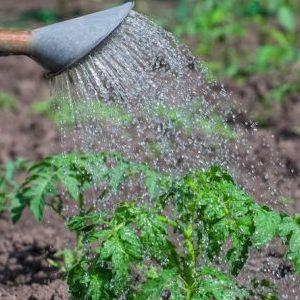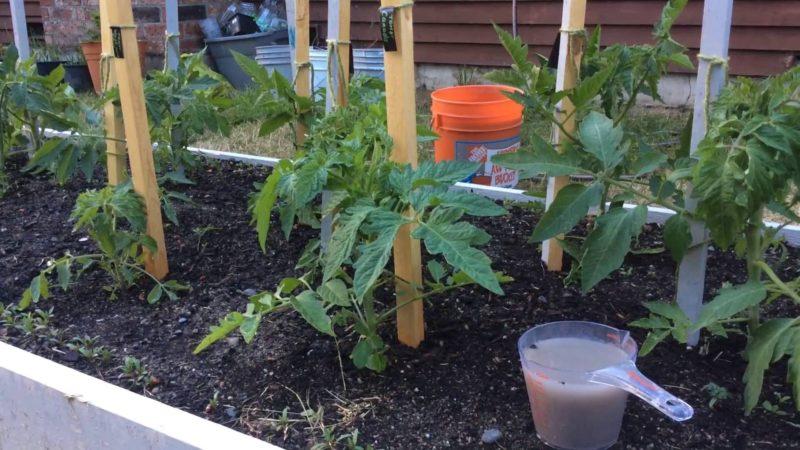How to feed tomatoes with boric acid, iodine and ash: prepare the solution and apply it correctly
On forums, gardeners often discuss ways to increase the yield of vegetable crops. Experienced tomato growers share recipes for fertilizing with boric acid and talk about the results. Thus, from a tomato bush you can harvest 20-30% more than the yield declared by seed producers. An enviable result, isn't it? If you want to know one of the most popular recipes, read our article.
The benefits of iodine, ash and boron for tomatoes
The traditional recipe for fertilizing is based on three components: iodine, boron and stove ash. Let's look at how they are useful for tomatoes:
| Component | What are the benefits of tomatoes? |
| Iodine
|
Improves nitrogen metabolism. Increases productivity and provides plants with additional nutrition. Makes tomatoes resistant to diseases |
| Boric acid
|
Boron increases the sugar content of fruits and improves their keeping quality. In addition, boric acid is an active agent in the fight against late blight.
If there is not enough boron, the tomato:
|
| Ash | Ash for fertilizer is taken from a fireplace or stove - wood, but not coal. For tomatoes, this is a source of natural potassium and phosphorus, which are responsible for the formation of the plant’s root system and fruiting. |
Attention! There is an opinion that iodine has virtually no effect on viral diseases of tomatoes (late blight, powdery mildew, etc.). This is false: iodine helps control (though does not cure) these diseases.
When to add and how to prepare
There are three phases of plant growth when tomato bushes need boron-iodine-ash fertilizing:
- Seedling. Fertilizer is used to increase the green part of plants.
- Flowering and appearance of ovaries.
- Fruiting period.
Feeding in all of the listed phases of growth and development of tomato bushes gives a decent result. In general, productivity increases by 20-30%.
To prepare the fertilizer, add to 10 liters of water:
- 1 teaspoon of boric acid;
- 2 liters of wood ash or ash;
- 30 drops of iodine tincture (from the pharmacy).
All ingredients are thoroughly mixed until completely dissolved.
Important! Experienced tomato growers advise heating the water to at least 50-60 degrees. This is explained by the fact that the crystals will not dissolve in cool water and the plants can get burned.
Rules and feeding scheme
Tomatoes are fed in two ways:
- By the leaves.
- Under the root.
On tomato seedlings foliar feeding done when the second pair of true leaves appears. It is important not to miss this moment, because the right time for feeding is a guarantee of half the result. The leaves are sprayed on both sides.
The solution is sprayed from a spray bottle so that a light mist forms near the bush. In this case, it is advisable not to irrigate the plants so much that visible drops settle on the surface of the leaves.
Many tomato growers prefer to feed by foliar feeding. After preparation, the solution used is cooled to room temperature.
 When root feeding, the nutrient solution is poured under the root directly into the soil. Before fertilizing, the soil under the plants is spilled with ordinary water. This makes the fertilization process more efficient. With the root method of fertilization, the prepared aqueous solution is applied at the rate of 0.5 liters per tomato bush.
When root feeding, the nutrient solution is poured under the root directly into the soil. Before fertilizing, the soil under the plants is spilled with ordinary water. This makes the fertilization process more efficient. With the root method of fertilization, the prepared aqueous solution is applied at the rate of 0.5 liters per tomato bush.
Attention! Ash can be added directly to the ground without making an aqueous solution. The soil around the tomato bush is “powdered” at the rate of 2 tbsp. spoons of ash per plant.
Advice from experienced summer residents
It happens that summer residents make mistakes when using fertilizers with boric acid. To avoid them, it is better to fertilize tomatoes:
- In dry, cloudy weather, as well as in the morning or evening: the fertilizing is better absorbed and the plants do not get sunburned.
- Under the root. In this case, before applying fertilizing, it is advisable to water the tomato bush with plain water.
- It is advisable to take a break of at least 12-14 days between any fertilizers for tomatoes.
- It is not recommended to prepare the solution in advance. Over time, its usefulness decreases.
- You should not use fertilizer with boron, iodine and ash more than three times per season.
Read also:
How to feed tomatoes during flowering and fruiting.
The best recipes for bread supplements for tomatoes.
How to feed tomatoes during flowering in the greenhouse and fruiting.
Reviews from tomato growers
The composition of boric acid, iodine and ash is very popular among summer residents who grow tomatoes. Many note the effectiveness, convenience and possibility of using the solution for both root and foliar feeding.
Margarita Terekhovich, Tver: “I have been looking for the best fertilizer option for tomatoes for a long time. A neighbor in the country suggested how to feed tomatoes with boric acid, iodine and ash.I alternated root and foliar feeding. The result was impressive! Now this is the only way I fertilize tomatoes.”
Anatoly Verkhny, Smolensk region: “Every season I use the same fertilizer for tomatoes and am always satisfied. I spray the plants with an aqueous solution of wood ash, boric acid and iodine. The tomatoes set well, are pleasing in size and are stored for a long time. I recommend it to everyone."
Alexandra Zolotukhina, Kopeysk: “In our short summer, we want to have time to get a full harvest of tomatoes. I try to speed up the process of their maturation in the greenhouse and feed them with a complex containing a solution of boric acid, iodine and ash from the stove. The tomatoes have time to ripen. Plus this is good protection against late blight, which is very pleasing!”
Let's sum it up
Most tomato growers advise fertilizing tomatoes with a complex of ash, iodine and boron. As a result, the absorption of nutrients in plants, the formation and number of ovaries on the bushes increases, and the likelihood of late blight in tomatoes is reduced.
It has been practically proven that such fertilizing increases the yield of tomatoes by 20-30%. Try boron-iodine-ash fertilizer and get a rich harvest of tasty and juicy fruits!